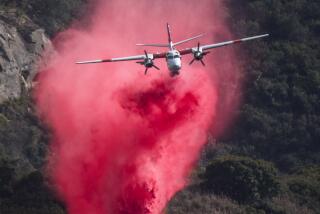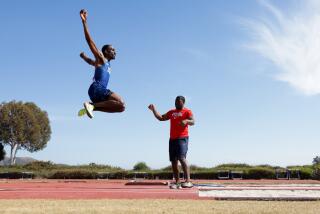PUTTING : The Pair in Paragliding : First-Timers in This Sport Can Reduce Fear Factor by Taking Off With Instructor
- Share via
SAN BERNARDINO — “Runrunrunrunrun!”
The voice shouts from be hind with a do-or-die urgency as you charge downhill toward the precipice.
“Run hard! Don’t stop!”
So, you run as hard as you can until your feet are barely touching the ground and then you are pawing the air like a cartoon character that has just stepped into space. You tuck your legs to avoid the sagebrush and hope. Running headlong toward a cliff requires a death wish or the faith that soon--very soon--you can fly.
And you do. You are paragliding--tandem paragliding, linked in harness with the instructor.
“You’re going to be anywhere from slightly nervous to terrified,” Mark Wright has warned. “I hope you’re going to be scared. Fear is extremely healthy. If you’re not scared, you have no respect for the sport.”
OK, you think, I do respect the sport, I do respect the sport.
Wright has even acknowledged, by way of reassurance: “ I am going to be scared, because I’m taking a passenger with me, and I feel fearful for you. I want everything to go well, and I don’t want anything to go wrong.”
Paragliding, for many participants a spinoff of hang-gliding or sky-diving, is a relatively new sport, and tandem paragliding has come into vogue in only the last year--probably inspired by tandem sky-diving in which the expert is strapped to the back of the novice so that anyone can experience the thrill of falling out of an airplane.
“It’s a natural progression to add tandem to paragliding, but it has to be done very carefully,” Wright said. “It’s the type of thing that can make or break the sport.”
Talk of breaking things brings up some differences between hang-gliding and paragliding. Hang-gliders fly faster and, as a training video points out, because the pilot hangs prone from a V-shaped fixed wing, most hang-gliding injuries involve the head, neck and back.
Paragliders use a collapsible nylon canopy similar to but larger than a modern parachute, with openings in the pockets to capture the air and provide an aerodynamic shape. Maneuvers are controlled by a network of lines, or “risers.” Because the pilots are either sitting or hanging upright, ankles and legs are most vulnerable.
Tandem paragliding requires some participation by the passenger, who, if not a certified pilot, is required to be registered with the United States Hang Gliding Assn. as a student. The association governs paragliding through an exemption from the Federal Aviation Administration, which considers the USHGA better qualified for the role.
Wright, who operates Performance Designs Paragliding School in Moreno Valley, is one of only four instructors in Southern California rated high enough by the USHGA to fly tandem with beginners.
“Tandem is popular for people that aren’t sure whether they want to do paragliding,” Wright said.
Rob McKenzie of San Bernardino said: “It’s an excellent training method. That’s basically how we teach. It’s not just a ride. The student is required to do everything. They take the controls, make decisions.”
Cary Mendes of San Jacinto says all of his tandem flights have been instructional. Marcus Salvemini of San Diego is the Southern California administrator for tandem paragliding--the instructors’ instructor--and emphasizes safety, lest the FAA perceive it as too dangerous.
“That exemption is guarded very closely,” Salvemini said. “If we abuse, it we lose it.”
But tandem flying allows a novice to see if he likes it without having to go solo.
“It’s a lot more enjoyable to do a tandem flight than spend a day on a training hill,” Wright said. “If they get a good flight and enjoy the experience, they are more likely to want to look at it further.
“(Also) once you get comfortable with the training hill, coming up 2,000 feet of mountain is another thing altogether. For students that are very scared of their first high-altitude flight, some will do a tandem flight for their first one.”
*
A training hill is only a few hundred feet high. Here, atop the rounded knoll called Marshall Peak behind Cal State San Bernardino, the launch site is 2,200 feet above the flatland below. The preflight instructions include discussion of a list of seven questions, such as:
--Have you recently watched modern paragliders . . . and do you have a basic understanding of the processes involved?
--Do you understand that you and the Pilot must run efficiently together to produce enough airspeed to launch?
--Are you aware of the possible reasons for . . . the deployment of a backup parachute?
“Of all the flights I’ve been on--well over a thousand--I’ve never, ever once had to use an emergency parachute,” Wright said. “I’ve done (more than) 1,200 sky-dives and never had to use an emergency parachute. But that doesn’t mean to say I’d consider for a minute going flying without one. There is always a chance that something will go wrong. Serious turbulence can just fold up the wing.”
First, the problem is getting off the ground. Wright explains:
“The basic procedure for launching a glider is--once you’ve done all your checks and you know you have your equipment on correctly--you pull the glider up into the wind and allow it to fly over your head. You (use control lines) to keep it stabilized and flying nicely over your head (while looking for) tangled lines and anything like that. Once you’ve assessed that everything is good, you continue with the launch, which means you start running down the slope.
“A very important thing to remember is to run as fast as you’re told or as slow as you’re told. If at any time we need to abort the launch, I’m going to say to you, ‘Stop running,’ and I’ll bring the glider down.
“At some stage you may feel it’s kind of out of control, that you’re just running blindly down there. It’s not. You’re 50% of the power to the aircraft. I have to rely on you doing 50% of the job. But you’ve never done this. You see the hedge coming up, and you’re not sure what’s going on. I know exactly what’s going on, and I’m timing our run to get the glider to lift us off.
“If I’m not comfortable with it, I’m going to stop and yell, ‘Stop!’ We can do it 10 times. But if we have the glider up and it’s square over our heads, the faster we run the easier we leave the ground.”
The passenger, harnessed in front of the pilot, is told to hang on only to the front straps of his harness “so you cannot interfere.”
There are several control lines leading to the wing. The student is told not to touch any of them.
“If you reach up and grab one of those things and pull down, you can seriously affect the wing,” Wright says. “You can stall.”
*
They wait until the wind increases, then run like mad. A second after launching, the glider rises suddenly as it gains speed and the aerodynamics kick in. The flyers settle back on slat seats built into their harnesses.
For the first few minutes the aircraft descends steadily--”sinks,” in glider jargon--then is buffeted when it enters a thermal updraft. The student is surprised to feel a bit queasy; it looks so smooth from the ground.
Wright exclaims, “Oh . . . here’s a good thermal,” and soon the flyers are soaring almost 1,000 feet above the launch site. A red-tailed hawk follows them up in lazy circles.
The only thing to worry about is landing. The idea is to hit the ground running until the glider collapses.
“You’re going to wiggle forward out of the seat and let yourself hang in your harness again,” Wright says. “Put one foot in front of the other. When we hit the ground, if I say roll left or roll right, the moment you feel the impact of the ground you just fall over sideways.”
Wright yanks on some lines to collapse the ends of the wing--creating what the pilots call “big ears”--and accelerate the descent for a remarkably smooth landing near a flock of sheep. The two need to run only a few steps, remaining on their feet.
It was a good flight. Wright, a Briton by birth, is no relation to the Wright brothers but feels a kinship to the aviation pioneers.
“They had the right idea,” he says. “But then it became big business. It’s time to get back to real flying.”
*
Certified Tandem Paragliding instructors: Robert McKenzie, San Bernardino, (909) 883-8488; Cary Mendes, San Jacinto, (800) 338-6359; Marcus Salvemini, San Diego, (619) 452-3203; Mark Wright, Moreno Valley, (714) 697-4466.


